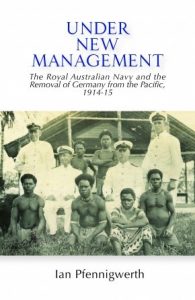- Author
- Book reviewer
- Subjects
- History - WW1, Book reviews, History - pre-Federation, Naval Engagements, Operations and Capabilities
- Tags
-
- RAN Ships
- None noted.
- Publication
- March 2015 edition of the Naval Historical Review (all rights reserved)
Under New Management – The Royal Australian Navy and the Removal of Germany from the Pacific, 1914-15. By Ian Pfennigwerth. Echo Books, West Geelong, Victoria, 2014. Soft cover of 182 pages illustrated with black and white maps and photographs, rrp $24.95.
 This comprehensive book is well researched and not only provides a compelling story but also a useful reference in one relatively small volume. Even today Australians have a poor knowledge of Papua New Guinea (PNG) which is by far our nearest neighbour. The author helps overcome this lack of understanding through a story of the fledgling Royal Australian Navy’s involvement in its first campaign in this then remote region.
This comprehensive book is well researched and not only provides a compelling story but also a useful reference in one relatively small volume. Even today Australians have a poor knowledge of Papua New Guinea (PNG) which is by far our nearest neighbour. The author helps overcome this lack of understanding through a story of the fledgling Royal Australian Navy’s involvement in its first campaign in this then remote region.
We learn of the early history of Papua New Guinea where many explorers ventured through these relatively isolated and inhospitable lands in search of trading opportunities. As no colonial power sought to claim the eastern portion of New Guinea it was left to German trading houses to establish European settlements, leading to an agreement reached in 1886 between Britain and Germany on geographic boundaries between their areas of competing interests in the Pacific region. Australia, especially the Queensland Colonial Government, saw this as a threat to their sovereignty.
The formation of a well balanced and formidable Australian fleet is explored with its early call into service to confront the German East Asiatic Squadron by undertaking an attack on German possessions in the Pacific. The Australian Naval and Military Expeditionary Force (AN&MEF) of 2,000 men was raised under the overall command of the Australian fleet commander, Vice Admiral Sir George Patey. Remarkably, within days of the declaration of war the AN&MEF was mobilised, kitted out and embarked for training and battle.
The first armed encounter with the enemy, resulting in Australia’s first war-time casualties and the loss of submarine AE-1, occurred six months before the better known Gallipoli campaign. The recorded memories of Commander Stan Veale, RANVR, who was then a midshipman, are a vivid reminder of the dangers faced in this action to attack and secure an enemy radio station in what became known as the Battle of Bita Paka. The book goes on to explain the wider ramifications of the war at sea leading to the elimination of the German East Asiatic Squadron and thence a German presence from the Indian and Pacific Oceans. This of course led to later Australian involvement in the mandated administration of PNG.
While the RAN committed itself admirably throughout this conflict there was at times some confusion in the command structure with a lack of appreciation between military and naval areas of responsibilities. In such a wide ranging history some minor errors are expected but these are minimal and do not affect the overall story. The book however admirably demonstrates the important contribution made by a very young navy in extending Australia’s national influence throughout the Pacific region.
Reviewed by Leyland Wilkinson




